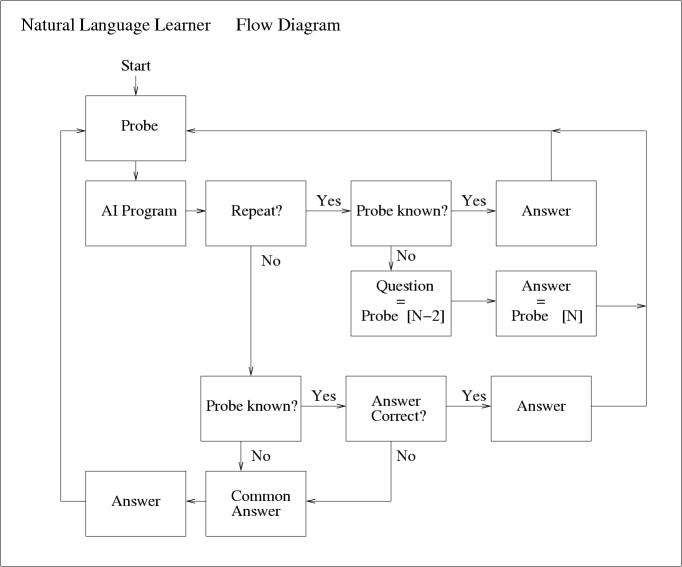
Good evening. I decided to post something. Considering that I got my wifi working, I ought to be posting on JF once again. After such a long time, you probably didn't think I was coming back. There are many extremely good reasons why I'm back, but I won't divulge them for sake of temporary privacy of my immediate personal thoughts. That's something you never thought you'd hear from me, eh? You won't hear it very often.
So the picture above is a poorly done flow diagram for a system of AI. Specifically a natural language learner. If you are looking at the low resolution version of this picture, click the round button on the left titled "Lo". Same text, bigger picture. The flow describes a simple logic system for an ai that repeats what it reads if given proper input. Proper input is very simple:
1) User: Question Q1 AI: A1 = Answer(Q1) 2) User: Answer A2 AI: A3 = Answer(A2) 3) User: Answer A2 AI: Answer A3 4) User: Question Q1 AI: Answer(Q1) = Answer A2 For Example: User: Hello. AI: No. U: Good morning. A: Yes. U: Good morning. A: Yes. U: Hello. A: Good morning.
In the first three steps, the AI learns the Question Q1 and Answer A2. In the fourth step, the user confirms that given Question Q1, the AI will return Answer A2. The first step introduces the question. The second step introduces the answer. The third step confirms the answer. The fourth step confirms that the AI agrees. An AI might disagree if a user has contradicted the current user. All the user would need to do to add a question/answer pair would be to say: Question, Answer, Repeat Answer.
While this pattern does nothing to solve several problems at different levels of the AI problem, it solves an immediate issue of training a robot to agree with things repeated. It also solves the problem of contradiction by using a system of fuzzy logic based on ratings.
This method could also be used on the word level (rather than the sentence level) to parse sentences. Such a system might look like this:
User: Question Q1 = {W1 W2 W3 W4 W5}
AI: A1 = Answer(Answer(W1) &
Answer(W2) & Answer(W3)
& Answer(W4) & Answer(W5))
For example:
User: Q1 = Why did the chicken
cross the road?
AI: A1 = Answer(Answer(Why) &
Answer(did) & Answer(the) &
Answer(chicken) &
Answer(cross) & Answer(the) &
Answer(road)) = "I don't know."
User: A2 = To get to the other side.
AI: A3 = No.
User: A2 = To get to the other side.
AI: A3 = No.
User: Q1 = Why did the chicken
cross the road?
AI: A2 = To get to the other side.
Sadly, humor would be lost on a robot. But, the word level would be possibly usable. The answer to words would be useful and getting information on those words would lead to a database of meanings which would facilitate understanding for higher level functions.
Looking back on this, it is simply an efficient way of collecting garbage data from humans who know a little about what they are talking about. It involves a feedback loop which allows humans to ask and answer as much as they know as well as they know.
Permalink
-
Leave a Reply





Comments: 0
Leave a reply »